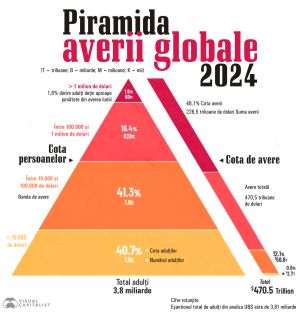The merger of the two Romanian exchanges - the one in Bucharest and the one in Sibiu - is once again being brought up, as the shareholders of the BSE are being asked to decide on the matter, in the General Shareholder Meeting of April 26th.
The management of the Bucharest Stock Exchange has told its shareholders that it intends for the BSE to merge with Sibex, which would subsequently disappear.
"After almost 10 years since the first attempt to complete a merger, it is even clearer that the existence of two separate market infrastructures, with separate trading and settlement systems, essentially serving the same group of users, is not an optimal solution", the management of the BSE says. "The capitalization that is less than 20 billion Euros for the domestic stocks and the regional/global nature of the competition in the industry are making the need to unify activities on each category of services provided by stock exchange groups even more valid. From this point of view, the Romanian stock market should tend towards a single chain of market infrastructures for trading, clearing, settlement and ancillary services. On the other hand, considering the fact that for more than four years now, SIBEX has constantly been causing losses to its shareholders, without any outlook for a turnaround, there is a need to identify solutions that would facilitate the adequate protection of investors and customers on both lines of business currently managed by SIBEX: the spot market and the derivatives market.
We also feel that beginning the talks/negotiations concerning a potential merger at the current time would create the premise for a more effective use of the financial resources of SIBEX which are currently focused on its subsidiary, the Sibex Depository. For example, it should be taken into consideration that the available resources should be directed towards a series of projects that would result in the expansion of the stock market, instead of perpetuating the current situation, which is characterized by the prolongation of losses".
The arguments in favor of the merger, according to the management of the BSE, are:
"a) potential added-value to the shareholders of the BSE, as a result of the increase in the net assets of the BSE, implicitly due to the investments made by SIBEX in subsidiaries.
b) the simplification of operations tied to the management of five markets and two post-trading infrastructures, as well as the more effective allocation of resources,
c) the potential consolidation of the position of the BSE in the region and on locally, because a single entity will be employed in supporting Romanian companies and the Romanian economy,
d) the more efficient use of the financial resources of SIBEX, currently focused on the SIBEX Depository, which could be directed towards various projects for the development of the stock market,
e) premises for the optimization of the cost structure for brokerage firms and lending institutions who are members of both spot markets, as a result of the technological infrastructure, of the operations and processes, with a potential for the optimization of investors' costs, given that investments/transactions could be achieved through the same trading and after-trading infrastructure,
f) potential synergies which could result in the increase of the profitability of the BSE".
BSE management states that, "according to the financial statements available for the first semester of 2015, SIBEX has interests in Casa Română de Compensaţie S.A. (41.194%) (the Romanian Clearing House) and in Depozitarul Sibex S.A. (73.136%), (the Sibex Depository), whereas its net investment in the subsidiaries amounts to approximately 16.14 million lei, of which 97% in the depository": "On the other hand, given the level of the activity seen at SIBEX, we think that the operations of SIBEX would only bring a marginal contribution to the level of the operating cumulated operational revenues (post-merger). For example, the trading revenues posted by SIBEX in the first semester of 2015 from all of its markets represent less than 0.1% of the BSE's revenues obtained from the same activities.
Given the current context, when a merger through absorption were done, following the approval of the merger project, we expect the following relevant effects/results:
a) the BSE will consolidate its financial position;
b) the BSE will become the only market and system operator in Romania which will have the ability to manage, after the merger: a regulated spot market, a regulated term market and an alternative trading system;
c) the existence of a single central depository in Romania that would concentrate the services specific to all the issuers and participants in the system;
d) a unified approach concerning the solution for the Central Counterparty (CPC) services. The passing of the solution that concerns the concept of regional CPC for the spot market operations could support the viability of the implementation of the services of the central counterparty currently used by SIBEX for the clearing-settlement of derivatives;
e) The BSE can expand its range of services with derivatives listed on SIBEX which has relevant local underlying assets, as well as other underlying assets, including an international index;
f) the use of potential eligible losses accrued by SIBEX (and the other companies in the group) for fiscal optimization".
The officials of the Bucharest Stock Exchange think that due-diligence must be done to allow finding and evaluating the legal and financial aspects concerning the activity of SIBEX, as well as estimating the best and most practical legal solution, which would allow incorporating the activity of SIBEX within those of the BSE.
In the General Shareholder Meeting of April 26th, the BSE shareholders will also decide the distribution of dividends of 6.66 million lei (0.8687 lei/share), out of last year's profit.
The agenda also includes the discussing of a business strategy for the 2016-2020 period.
During the previous term, the Board of Directors of the BSE followed a draft strategy, which was never completed, even though, in 2012, Lucian Anghel said in his first press conference that it would be together with the future CEO.
Meanwhile, the EBRD has become a shareholder of the BSE, and in the December elections, the former has imposed a representative of its own in the management structure of the BSE.
It seems it is the EBRD that has asked for a business strategy this time.
The boost to the talks about the Central Counterparty seems to be at the hand of the EBRD as well.
• The Central counterparty, on the agenda
The BSE shareholders are also expected to discuss, in the General Shareholder Meeting, the on principle approval of the implementation of the foreign Central Counterparty solution for the markets managed by the BSE, a solution which has the potential to lead towards the regional Central Counterparty concept, having the BSE as a component of this concept. The General Shareholder Meeting will take under consideration an investment of at most 2 million Euros, which would allow the BSE to obtain the status of shareholder of the foreign Central Counterparty, which could become a regional Central Counterparty.
Since September 2013, the European regulations require connecting to an authorized Central Counterparty for the settlement of derivatives, and such an entity will also be necessary for the spot market as well, starting in 2017.
The institution needs a capital of at least 7.5 million Euros in order to be authorized.
Sibex and the BSE have failed to reach an agreement on the creation of a local Central Counterparty, and last summer the European Bank for Reconstruction and Development (EBRD) presented a project concerning the creation of such an institution, at the region level.
According to the EBRD, a regional institution would involve a cost of about 1 million Euros for every ECE country, while the creation of local entities would involve a financial effort of 10-13 million Euros/country.
The EBRD has presented two options - the creation of a central counterparty on the structure of the entities which are already authorized or the creation of a new institution, opting for the former.






















































